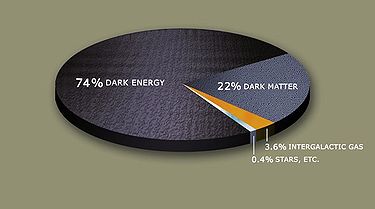Recently, Erik Verlinde proposed a revolutionary new perspective to gravity extensively discussed in this blog. He notes that gravity has all the characteristics of an entropic effect, and presents clear arguments that gravitational attraction between massive bodies can be considered as resulting from nothing more than a growth in number of bits required to describe the system of massive bodies. Key is that this description of the physical system is holographic in nature, with the bits describing reality residing at holographic screens.
 I previously posed the question “can dark energy, just like gravity, be understood as an entropic effect?”.
I previously posed the question “can dark energy, just like gravity, be understood as an entropic effect?”.
To my astonishment, it appears that a quick 10 minute exercise in determining the entropic force exerted on the entire observable universe indeed yields an effect with the right order of magnitude to explain the cosmic dark energy (or cosmic acceleration). It seems that a dark energy effect emerges from Verlinde's holographic description. All 123 orders of magnitude of the dark energy mismatch evaporate when considering the cosmic acceleration as a result of a holographic entropic force.
The line of reasoning is as follows (for ease of notation I will work in natural units and leave out factors c, G and h-bar):
Consider the cosmic horizon (the edge of the observable universe: a sphere with radius R approximately equal to 2.7 1061 in natural units)
According to the holographic principle the observable universe is encoded in N =
bits located at the cosmic horizon,
A finite temperature T is associated with this horizon. This temperature is determined by an equipartition of the energy Mc2 contained within the horizon over the bits (degrees of freedom) associated with the horizon. Here M = 1.4 1060 is the observable mass of the universe. Using the equipartition expression ½kT = M/piR2, it follows that kT = 3 10-64.
An entropic force F = kT grad(N) = kT grad(pi R2) =2 pi kT R is associated with the horizon. This results in a cosmic expansion (1/R) d2 R/dt2 = F/MR = 2 pi kT / M = 1.3 10-123. Presto!
--- Postscript ---
Two critical notes to the above speculative derivation need to be mentioned here:
As I set out to explain more than a hundred orders of magnitude mismatch, I have not bothered myself with numerical factors of order unity. As a result,the end result could be off by a factor of two or so.
More importantly, a full evaluation of the above simple expansion model yields an expansion (1/R)d2R/dt2 = (2c/R)2. Whilst this expression yields the right order of magnitude for the expansion, it is not constant and therefore not in line with the full Lambda-CDM model cosmological model. Is it a coincidence that the current value of the dark energy density comes out right? Or does the Lambda-CDM model need a modification?
Keen to get your comments to above speculations!




Comments